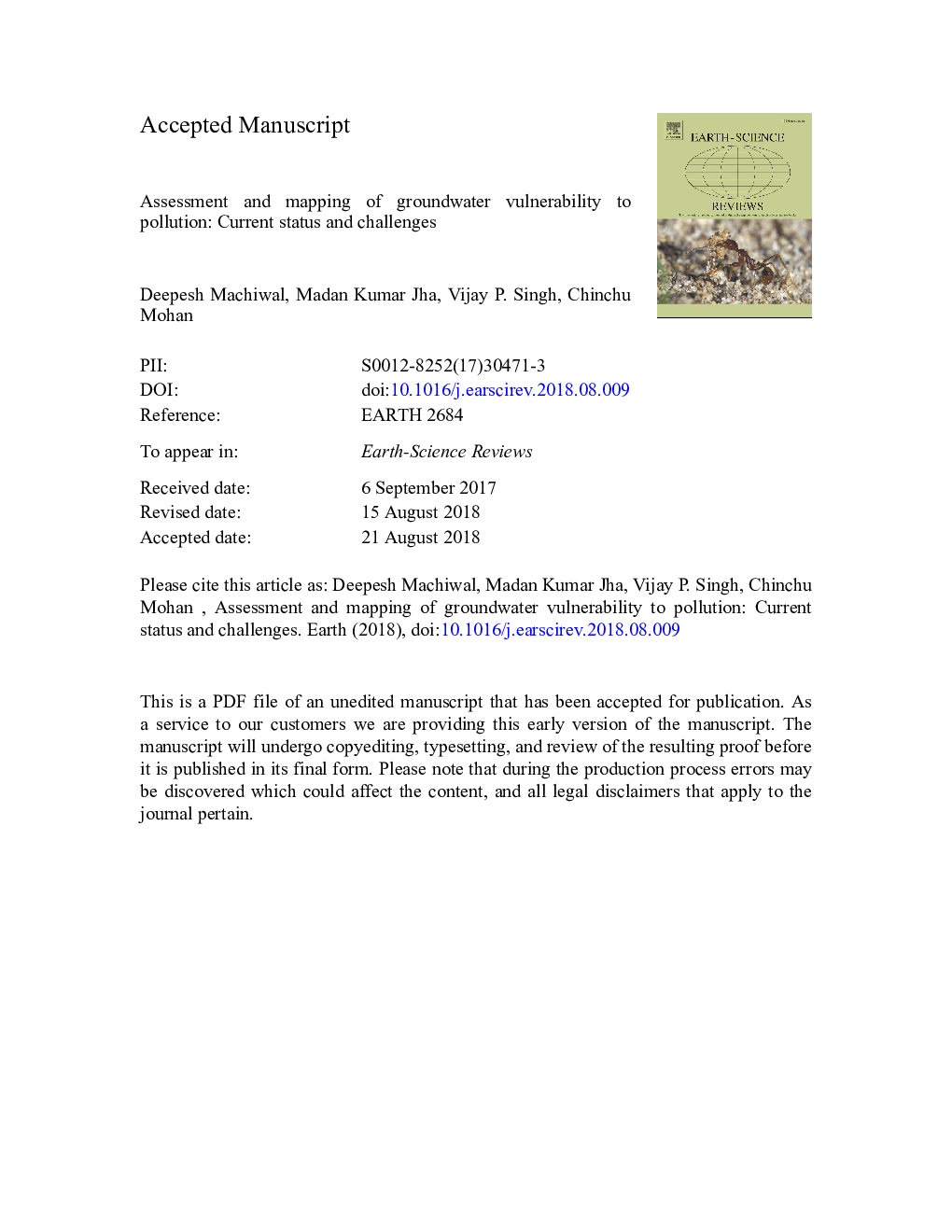| کد مقاله | کد نشریه | سال انتشار | مقاله انگلیسی | نسخه تمام متن |
|---|---|---|---|---|
| 10120718 | 1639918 | 2018 | 122 صفحه PDF | دانلود رایگان |
عنوان انگلیسی مقاله ISI
Assessment and mapping of groundwater vulnerability to pollution: Current status and challenges
ترجمه فارسی عنوان
ارزیابی و نقشه برداری آسیب پذیری آب های زیرزمینی به آلودگی: وضعیت فعلی و چالش ها
دانلود مقاله + سفارش ترجمه
دانلود مقاله ISI انگلیسی
رایگان برای ایرانیان
ترجمه چکیده
افزایش آلودگی آب های زیرزمینی در سرتاسر جهان، مفهوم آسیب پذیری آبخوان را به وجود آورد که در طول سه تا چهار دهه گذشته، توسط محققان و سیاست گذاران برای حفاظت از آب های زیرزمینی از آلودگی، گسترده شده است. با این حال، تنها چند مطالعات اخیر بر روی ارزیابی عملکرد دو یا چند روش ارزیابی آسیب پذیر تمرکز کرده اند. برخی از این مطالعات به نتایج متضاد منجر شده است. با توجه به این واقعیت و با توجه به افزایش خطر آلودگی آب های زیرزمینی به دلیل افزایش فعالیت های انسانی در سراسر جهان، ضروری است که از روش های موجود، روش های موجود تحقیقاتی و چالش های عمده مرتبط با ارزیابی آسیب پذیری آبخوان ها را بررسی کنیم. از این رو، هدف این مطالعه ارائه یک بررسی جامع از روش ها و رویکردهای مورد استفاده برای ارزیابی آسیب پذیری آبخوان برای حفاظت از منابع و منبع است. اول، مفهوم و انواع آسیبپذیری آبخوان همراه با تعریفاتی که طی سالها تکامل یافت، ارائه شده است، و سپس روشهای ارزیابی آسیبپذیری آبرفت مناسب طبقهبندی و خلاصه مورد بحث قرار میگیرد. دوم، مفهوم ارزیابی آسیب پذیری برای حفاظت "منبع" برجسته شده است، و تکامل روش های ارزیابی آسیب پذیری آب های زیرزمینی با یک بلوک بلوغ روشنگر ارائه شده است. سوم، روند تحقیق و انتقادات موجود در مطالعات قبلی مورد بحث قرار گرفته است. چهارم، چالش های عمده در ارزیابی آسیب پذیری ها برجسته شده و راه پیش رو پیشنهاد شده است. به این نتیجه می رسیم که پیشرفت روش های ارزیابی آسیب پذیری با پیشرفت دانش و ابزار / تکنیک ها هماهنگ نیست. یک نیاز فوری برای توسعه یک روش علمی قوی و تا حدودی همه جانبه برای ارزیابی آسیب پذیری "درونی" و "ویژه" در زیرزمینی برای حفاظت از "منابع" و "منبع" تحت شرایط مختلف آب و هوا و آب و هوا وجود دارد. تأکید دارد که مطالعات بیشتر باید به ارزیابی آسیب پذیری برای حفاظت از «منبع» با استفاده از رویکرد «مسیر منبع-مسیر گیرنده / هدف» اختصاص داده شود. همچنین، سیستم های پشتیبان تصمیم فضایی باید با استفاده از ابزار / تکنیک های مدرن از جمله هوش مصنوعی برای بهبود فرآیند تصمیم گیری برای حفاظت از منابع آب زیرزمینی توسعه یافت.
موضوعات مرتبط
مهندسی و علوم پایه
علوم زمین و سیارات
زمین شناسی
چکیده انگلیسی
Increasing groundwater contamination across the globe triggered the concept of “aquifer vulnerability”, which has been extensively used worldwide during past three to four decades by researchers and policy makers for protecting groundwater from pollution. However, only a few recent studies have focused on the performance evaluation of two or more vulnerability assessment methods. Some of these studies have resulted in contrasting findings. Given this fact and considering growing threat of groundwater contamination due to increasing human activities across the globe, it is necessary to critically review existing methods, understand current research trends, and identify major challenges associated with the assessment of aquifer vulnerability. Hence, the aim of this study is to present a comprehensive review of the methods and approaches used for the evaluation of aquifer vulnerability for 'resource' and 'source' protection. First, the concept and types of aquifer vulnerability along with the definitions evolved over the years are presented, and then the methods for assessing aquifer vulnerability are suitably classified and briefly discussed. Second, the concept of vulnerability assessment for 'source' protection is highlighted, and the evolution of groundwater vulnerability evaluation methods is presented with an enlightening block diagram. Third, current research trends and critiques on past studies are discussed. Fourth, the major challenges of vulnerability assessment are highlighted and a way forward is suggested. It is concluded that the progress of vulnerability evaluation methods has not kept pace with the advancement of knowledge and tools/techniques. There is an urgent need for developing a scientifically robust and somewhat versatile methodology for the evaluation of 'intrinsic' and 'specific' groundwater vulnerability for 'resource' and 'source' protection under varying hydrogeologic and hydro-climatic conditions. It is emphasized that more studies should be devoted to vulnerability assessment for 'source' protection using 'Source-Pathway-Receptor/Target' approach. Also, spatial decision support systems should be developed using modern tools/techniques including artificial intelligence to improve decision-making process for protecting vital groundwater resources.
ناشر
Database: Elsevier - ScienceDirect (ساینس دایرکت)
Journal: Earth-Science Reviews - Volume 185, October 2018, Pages 901-927
Journal: Earth-Science Reviews - Volume 185, October 2018, Pages 901-927
نویسندگان
Deepesh Machiwal, Madan Kumar Jha, Vijay P. Singh, Chinchu Mohan,
